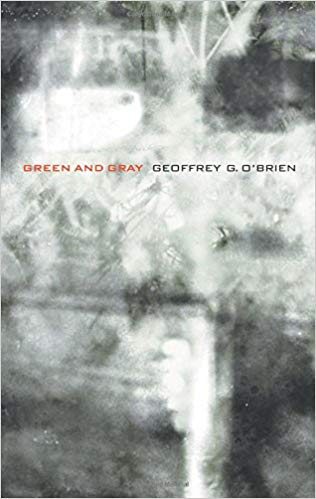Green and Gray is an exceptional book of poetry, a complicated and often difficult book, but not one in which the complexities and difficulty require readers to create their own meaning. Rather, the experience here is that of following the poet’s mind through the process of making meaning. This is the sort of poetry that makes thoughts like “This book is excellent and therefore I have a responsibility to read it” open into the actual and immediate pleasure of reading, and then further into engagement with the idea of reading itself, where one eventually looks up and says, “I can’t believe there are books.”
Green and Gray is also exceptional as a second book of poetry, in that it solves the problem that comes from writing a very good and very distinctive first book: how to go on without repeating yourself. O’Brien does this by using some of the same techniques as before, but in different and more complicated ways. For instance, compare how repetition works in “….” from The Guns and Flags Project: “The snow was the future perfect of snow,” “The snow was the perfect future of snow,” “The future of snow was the perfect snow,” to the way it works in “Hysteron Proteron” from Green and Gray: “heedless until explained; he begins to describe it; / Eve is claimed born across the water / and not yet proved; Eve is ‘made’.… abandoned, worked on, begins to be built; / ‘Eve’ is born; ‘Eve’ is claimed and made.”
O’Brien asks more than most poets do of their readers. These poems are not brief—thirty go beyond one page, six reach at least four pages—nor is their construction particularly simple. Consider the complexity of thought at play in “Logic of Confession”: “All photos are taken out of remorse / Are of where the senses go when closed / All photos are still lifes of the senses / Are at least of lost faith in the senses / I’ve therefore seen all possible photos / They aren’t like my experience.” To have thought placed upon thought like this is exciting, but over 102 pages, that excitement would become maddening, or, worse, deafening. Fortunately, these poems do not all work or sound alike. Variation here is not just apparent enough to fulfill a requirement, rather it is a constant strategy that keeps the reader attentive and better able to appreciate, for instance, the distance in lines like “the gray of the stone and green of the trees, / among a people hypnotized by sounds / as they could be by each other,” with the knowledge that in another poem that distance could just as skillfully be shattered: “I’m already screwing up the end of the poem / with a hopeful form of forgetfulness. / Let me confess to you that I plan a perfect poem.” Or consider how a reader’s encounter with a poem in a new form, like “They Met Only in the Evenings,” which is composed from a limited vocabulary set (words from the PATRIOT Act), is mediated by having encountered a sestina, like “Written on a Column,” a few pages before. This traditional form also uses a constrained vocabulary, an aspect of the poem made particularly apparent here by O’Brien’s choice of end-words (where, then, when, there, what, that).
Beyond the relief these variations provide on a local level, they carry a broader benefit by establishing O’Brien’s range, which, combined with his precision, helps render the decisions he makes in such a way that one can see decisions have been made. As a result, one trusts him more, so that ultimately, when he comes out to say something like “It’s like twilight to be alive now,” it’s easy to believe him.





